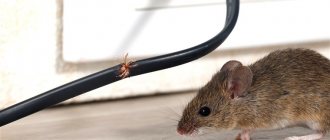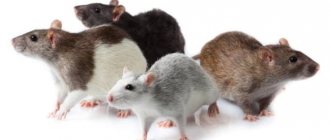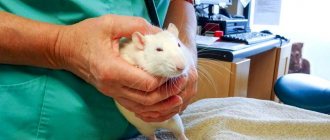If you have a pet rat, you've probably wondered: Can rats swim or not? Throwing a rat into a full bathtub is something you may not want to do until you read the answer to this question.
Yes, rats can swim! In fact, they can swim more than half a kilometer in open water. For such tiny animals this is an incredible distance. Although they can swim, pet rats may simply enjoy playing in the water rather than swimming.
Despite the fact that rats are associated with plague and dirt, they are quite intelligent creatures that are capable of experiencing stress. If you are a rat owner, do not force your pet to swim. In stressful situations, he may even drown.
Let's look at it in more detail
Cases when you can give this rodent a bath:
- The rat ate something inedible and then got wet.
- Lying on a bed that is no longer fresh for a long time makes your pet smell bad.
- The rat does not groom itself, does not wash itself, neglects (although this is rare, it can happen).
- if the rat has parasites.
- the animal is old, has difficulty caring for itself or is sick.
- found in males: the rat has a hairless tail.
- There are rats that simply love water treatments.
Diseases
It is worth immediately noting that the life expectancy of rats is short - about two years. Under good living conditions, they can live for 4 years. Interesting fact: the maximum age of a rat that has been officially recorded is 7 years. If you keep more than one rat, then quite often fights will arise, which will lead to injuries. They need to be treated.
Sphinx and Dumbo rats are quite susceptible to various diseases, because this is a product of gene mutations, which later negatively affect their health. As a rule, old age for them begins at the age of two years.
Healthy rats are moderately active and inquisitive. They sniff their owner or his hands. If the rodent is too lethargic or, on the contrary, too active, then this indicates that it has health problems
When purchasing a baby rat, you should pay attention to the following points:
- scratches, wounds or sores on the paws and tail; later they can cause other more serious diseases;
- bald spots;
- suppuration on the body;
- frequent sneezing;
- a wet area around the anus is a clear sign of an intestinal disorder;
- any suspicious discharge from the eyes, ears and even nose.
Domestic rats differ from their wild relatives in much poorer health. The former are prone to gaining excess weight and various cancers. To prevent these diseases, it is necessary to carefully monitor your pet’s diet. Separately, it is worth highlighting ticks, lice and other parasites that live on animals covered with hair. To get rid of them, it is necessary to detect the disease in time and treat the animals with special preparations.
When should you bathe your pet?
Experienced rescuers believe that bathing can harm an animal only if precautions are neglected or if the procedure is used inappropriately.
It should be washed in the following cases:
- the presence of impurities on the coating that are harmful to health if swallowed;
- Untidy appearance, and the age of the rat does not allow it to take care of itself;
- being in an uncleaned cage for an extended period of time;
- before the concert;
- in removing parasites.
In other cases, there is no need to bathe your pet. He will remove the dirt himself.
Rat animals are often cold, so drafts and cold water should not be used during treatment. If fluid gets into the ears, there is a risk of developing otitis media. After washing, the fur should be well dried.
Harm and benefit to humans
The underwater rat, despite its status as a pest, is used for fur production. The skin of a rodent is not of great value, but it makes warm products with smooth short fur.
Sometimes these rodents are kept at home as pets. It is not easy to purchase such a pet, since there are very few people who breed river voles.
The river rat does much more harm. It destroys crops and damages the roots of seedlings. It breaks up the soil, making harvesting impossible. Buries grain crops. Eats up supplies.
Destroys vegetation in pastures. Most often, invasion occurs in the fall with the onset of cold weather. Then the rodent migrates to drier, warmer and food-rich areas.
The pest is also a carrier of the following diseases:
- leptospirosis;
- Omsk hemorrhological fever;
- tularemia.
There is an active fight against the rodent. The following methods are used to kill river rats:
- I. This is a dangerous method, as other animals may suffer from the poison. Including pets. All kinds of poisons can destroy plants.
- Traps and mousetraps. They help best in enclosed spaces - barns or basements where supplies are stored.
- Cats are most effective on small farms.
To prevent the river vole from getting into the garden, you need to take the following actions:
- the fence must have a deep cement foundation. This way, the rodent will not be able to climb into the area through the tunnel.
- Plant onions and peppermint throughout the garden. Their smell is unpleasant to the pest.
- Burrs that stick to the fur are also unpleasant for the rodent. Therefore, you can scatter a small amount of them around the area.
- Singed wool repels pests.
- Ultrasonic repellers are effective.
Thus, river rats are pests with which humans wage a real war. These rodents are prolific, and therefore their number can increase exponentially.
River voles are most often found near water bodies. Therefore, residents of such areas should take care in advance to ensure that the pest does not choose their yard to collect supplies.
How they swim
To learn how rats swim, you can watch videos online posted by rodent owners. Animals feel great in water. They swim thanks to the rapid movements of their front and back legs.
With the help of the mouse's body, they maintain balance and determine the direction of movement.
Rats are good at diving and can stay in the water for a long time. Scientists have set a world record of 29 km for swimming rats.
The ornamented rat, like its wild brother, often enters the water only when there is danger. Although there are animals that do it for fun.
They love to swim in small pools or troughs. Swimming animals love to play and wash themselves.
But forcing a mouse to take a bath is not the answer. To get him interested, you need to tempt him with treats.
Then the curiosity inherent in rodents and the desire to eat something tasty will awaken in the animal the desire to swim.
Therefore, every rodent knows how to stay afloat. However, many of them use this skill not for pleasure, but for movement, communication, survival or feeding.
Habitat
The house mouse, the photo of which is presented in this article, is actually a wild animal. It got its name for living near humans. House mice live everywhere in the world, with the exception of permafrost areas, Antarctica and high mountains. The Latin name of the animal is Mus musculus, and a 3rd word is added to it, demonstrating the habitat area, for example, house mice that live in southeast Asia are Mus musculus castaneus. In our country, house mice also live almost everywhere: Krasnodar Territory, Rostov Region, Krasnoyarsk Territory, Astrakhan, etc. The only exceptions are the regions of the far north.
Swimming as fun
When a rat is in danger, it, like its wild counterpart, can save its life by moving through the water, but long swims are not particularly pleasant for domestic animals. However, observations by scientists and experienced breeders show that some pets love to splash around in water-filled pools.
The owner who considers it necessary to stimulate the animal's interest in bathing must find a suitable container for the rat. Sinks or bowls are suitable for this purpose, or you can purchase special bathing bowls.
The pool in which the rat will splash must meet the following conditions:
- optimal depth so that the animal can freely exit the bath; sustainable development;
- Size - ideally, the pool should be 2 times larger than the rodent itself;
- Walls should be rough, otherwise your pet may slip; The device should have a rubber mat at the bottom and a ramp or ladder at the edges.
For bathing, use only clean water: tap, bottled or filtered. The temperature should be determined by the comfort of the human hand.
Excessive cold can cause inflammatory diseases in animals, hot liquid can cause burns.
Forcing your pet to swim or dive is absolutely unacceptable. To develop his interest, you need to lure him with treats. Curiosity and gluttony will prevail over natural caution, and in the summer the rodent will happily splash out in its own bath.
Preparation for water procedures
In order to properly prepare for bathing your hamster, you need to purchase a small container for water procedures.
Some owners limit themselves to the sink, but this option is more suitable for experienced hamster owners. However, for Syrian hamsters it is still better to use a special shampoo for rodents. They have more sensitive skin than Djungarians. Hamsters should only be washed with your hands or a very soft sponge. The skin of these animals is very delicate and can be easily damaged if you use a regular washcloth. And this can lead to extremely negative consequences: skin diseases = dermatitis and allergies.
You also need to purchase a small ladle to make it convenient to water your pet. You should also make sure that there are no drafts in the room while bathing the hamster. Streams of cold air will be destructive for a wet hamster.
Return to content
A few rules for bathing
Rules to follow when bathing your rat:
- Bathing your pet should be short and gentle.
- Do not overuse shampoo, as it washes out the skin's oily protection and dries it out. If your pet doesn't get too dirty, simply rinse him under water.
- While bathing, it is best to talk to your pet; a familiar voice has a calming effect.
- After bathing, the rodent's natural odor also disappears, making it recognizable to relatives. If you have more than one rat, you must carefully return the bathing animal.
Sometimes, to soften your pet's skin, you can apply a natural oil to the coat after a bath.
Sometimes owners don't know whether to bathe rats when they sneeze or when the animal has injuries on its body. If this is the case, the rats should not be washed. Also, do not allow your pet to experience discomfort while bathing. If only the paws or tail are dirty, you can do a local pet wash.
Fact 1: Rat vision – external and internal
In order to imagine how rats see, it is enough to recall human colorblind people with extreme manifestations of the disease. Animals practically do not distinguish colors; the whole world for them is a collection of spots of different sizes and intensities that are in motion. Rodents' external vision is very poor, but they don't need it. Rats hear perfectly, distinguishing the direction and distance of even a subtle rustle, and can determine its cause. In addition, the animals have a delicate sense of smell and touch.
There is another incredible fact. Scientific experiments with rats have shown that test subjects have inner vision. In humans, this is called premonition, or the ability to see possible developments of events. This theory is supported by a well-known fact: rodents, which live in large numbers on board a ship, leave before it sinks. There are also more specific confirmations. For example, in the Stalingrad hell, animals left the city en masse before the next air raid. They also feel nuclear tests, running away from test sites several hours before the events.
When not to wash a rat
In some situations, it is not recommended to bathe your rat. The reasons may be related to his health or inadequate internal conditions.
Possible adverse effects of treatment:
- Colds as a result of the coat not being dried or not getting too cold;
- diseases of the organs of vision and hearing caused by moisture;
- Skin problems caused by inappropriate detergents or too frequent bathing.
Rat baths are prohibited if the following problems exist:
- Skin wounds. They may ignite after steaming and exposure to water.
- Your pet recently caught a cold or became ill while taking a bath. Complications may occur after a bath, and the recovery process may take several weeks.
Wiping and drying
There are two potential dangers in bathing a kitty rat. The first is that if water gets into the animal’s ears, the animal runs the risk of becoming seriously ill and even losing hearing. That is why, just in case, both cats and rats are bathed only up to the neck, and the head and face, if necessary, are simply wiped with a wet napkin. The second danger is related to the fact that, unlike a person, a rat, due to the presence of fur on its body, can dry for a very long time, while remaining wet, the frightened animal tries to hide as far as possible and hide from prying eyes.
Also read about how to bathe a chinchilla at home.
How to properly bathe a decorative rat at home
There are a few things to consider when bathing your rat. For example, there is no need to bathe the animal under running water. This is done only in extreme cases, when the rat gets dirty with something poisonous.
It is important that water does not get into your ears. Otherwise, there is a risk of otitis media. Rats' ears curl, closing the ear canal when they decide to dive. But if an animal is doused with water, it may not survive.
Dumbo rats should be bathed with extreme caution. Their ears are lower than other breeds and there is a high risk of water ingress.
Washing rats is faster and easier if everything is prepared in advance. For the bath you will need:
- Two swimming pools with warm water;
- Special shampoo for rodents;
- Two towels (paper and cloth);
- Sponge or soft cloth.
Without skills, it is better not to use brushes or sponges in order to better clean the rat’s fur, as this can injure the animal and cause it pain.
The depth of the water in the pool should be such that the animal can comfortably stand on all four paws, that is, no more than 5 centimeters. The water temperature should be between 30 and 35 degrees Celsius. In other words, it should be warm. If you don't have a thermometer, you can test it with your elbow.
Attention. Avoid drafts while bathing, as these animals have difficulty withstanding cold air while bathing and may become ill. A complication after a cold in the form of pneumonia leads to the death of the animal in 50% of cases.
The animal should be washed as follows:
- The rat is placed in the sink and dried with a damp cloth or rag;
- Take the shampoo and apply it to the animal's fur with your fingertips;
- After this, the rodent is carefully transferred to a container with clean water and the product is thoroughly washed, making sure that water does not get into the ears;
- Then dry the animal with a paper towel and wrap it in a cloth towel to dry further.
Washing the tail
Tail washing is necessary for even the cleanest animals. Rats do not clean their tails well, especially males. During the warm season, this part of the body becomes very dirty - dirt and dead skin particles accumulate on it.
To clean the tail, you need to prepare:
- soft brush;
- Hydromassage bath;
- strokes;
- Shampoo and cream without chemical additives and specific aroma;
- dry rags.
The first step is to soak in the dirt. If there is not much dirt, you can get by with water. For heavy dirt, add a little shampoo to the bath.
Processing is carried out in the following order:
- Wet the tail with a cotton swab. Treatment time depends on the degree of contamination and can be up to 10 minutes.
- Brush gently towards the tip of the tail.
- Rinse off any remaining shampoo and remaining water.
- Wipe the tail and lubricate it with cream.
If necessary, treatment can be repeated after a few days.
Drying
After treating the water, it is important to dry your pet's coat thoroughly. If you don't do it properly, it might get cold. Dry your rat twice - first with a dry cloth to remove excess moisture, and then wrap the animal in a soft towel.
Paper napkins absorb moisture well and lie gently on the skin. Do not press or make sudden movements.
To help your critter calm down in the towel, you can treat him to his favorite food. The owner's calm tone will make the rat feel safe. If you approach the treatment correctly and create comfortable conditions for him, he will calmly approach subsequent baths and even enjoy them.
Important: It is best to wash on a warm day. There should be no drawings in the room. The cage should be placed in a warm place, as rat fur takes a long time to dry.
Shampoo for rats
That washing rodents is not an easy task. Regular shampoos and soaps should not be used on kitty rats as they contain substances that can cause various skin problems in pets.
It is better to buy a special product for bathing rats, at least for kittens. When choosing a shampoo, it is important that it does not have a strong smell or no smell at all.
Some owners use mild baby shampoos for their rodents. This can be done, but you need to carefully study the composition of the product. Do you use a special shampoo for rodents?
How to wash a rat if it is afraid of water
If you want your rodent to get used to water, this can be done. The best option is a game. Of course, you must monitor your rodent during this entire time.
Take a shallow dish, such as a saucer, and pour some water into it. Let the rat explore, even let it go into the water. You can also wipe it with a sponge. Don't forget to give your pet a treat after play.
An animal not accustomed to water will be frightened not so much by the liquid itself as by the new environment or pressure noise. For this reason, experienced lovers of decorative rats recommend accustoming the animal to watering in advance.
To make bathing less stressful for your pet, simply brush his coat with a soft, damp cloth or cotton swab. It is best to avoid shampoo as it will be difficult to wash off.
Some rats are afraid of water. This is expressed in anxiety, the desire to flee and aggressiveness. The animals begin to itch and howl. In this case, take your time to get used to the water treatment.
First you need to show your rat that it is okay to play with water. Pour water into a flat container and let the animals experience their new environment under the supervision of the owner. You can lightly wet his fur. The rodent is then fed a treat to give it a pleasant experience.
Fear of swimming may not be caused by water, but by changes in the environment. The noisy sounds of running water and the loud voice of the owner can make the rat anxious. If the animal moves away vigorously while bathing, you can get a helper.
Caring for and maintaining a rat requires attention and knowledge on the part of the owner. Bathing is optional but can be done regularly if the animal enjoys running through water in the wild. The most important thing is to provide a safe and comfortable environment.
Precautionary measures
If a rat appears at home and you have no experience caring for it yet, then you should prepare for certain difficulties that can be expected at certain stages. The most exciting moment will be bathing your pet, especially for the first time. To protect yourself, you should wear something with long sleeves, in case the animal is not in the mood or is not ready for contact with water. If possible, it is better to ask a qualified person to show you exactly how to bathe and tell you about all the nuances.
Precautionary measures should be taken not only in relation to the owner, but also for the pet itself. If the rat is still small and has not had the opportunity to get acquainted with water, it is necessary to create optimal conditions for this, evoking positive emotions from the new element. If you neglect these recommendations, it may be very difficult to wash your pet in the future, especially if he really needs it
If you neglect these recommendations, it may be very difficult to wash your pet in the future, especially if it really needs it.
Although water procedures are carried out infrequently, it is necessary to know about those situations when they should not be used, otherwise there will be much more harm than good. It can be difficult for a non-specialist to notice any minor health problems in a pet, which is why life-threatening situations arise.
To avoid this if possible, it is worth knowing about the main reasons that prevent rats from bathing.
Features of rodents
Rats are often the subject of research by scientists. Moreover, science is interested not only in the bodies of rodents, but also in their intellectual abilities, mental and behavioral aspects.
These are unique animals. They communicate with each other using ultrasound without attracting the attention of predators. They can distinguish poisoned food from safe food, and can go without water for a long time. They survive high radiation levels, although they can die from severe psychological shock. It is believed that rats are able to laugh and have abstract thinking along with humans.
experiment by Didier Desor
Rats do not live alone, but in huge colonies, which are divided into groups. Groups have their own hierarchical system. These rodents easily adapt to any food, but they are also very picky.
Fun fact: Rats are known to be omnivores. But the young offspring will not eat everything. Through mother's milk, babies learn what foods are safe to eat. Before trying something new, the young ones watch the old ones to see if they eat the same thing.
Story
Interesting facts about rats are that the ancestors of rats lived on Earth about 50 million years ago. Scientists came to these conclusions after conducting a number of studies. Moreover, the first ancient people, or rather their predecessors, arose about 2.8 years ago. That is, rats inhabited the planet long before the emergence of humans. People appeared when rodents had already chosen the most suitable place to live. As a result, rats were forced to somehow get along with our ancestors. Subsequently, they followed people everywhere.
However, rodents soon began to annoy and cause inconvenience to humanity. As a result, people began to fight animals. But even active measures did not jeopardize their survival. To date, rodents are not in danger. They multiply so quickly that they are unlikely to ever disappear from our planet.
At the same time, rats are excellent at adapting. They survive in extreme heat, in arid climates, and in frosts. It’s not for nothing that they successfully survived numerous disasters.
There are about 70 species of rats on Earth today.
Rats on ships
If rats are so smart and can survive even in very unfavorable conditions, perhaps they really are capable of foresight? Scientists regularly study this phenomenon.
Interesting fact: why do all the swans in England belong to the Queen? Reasons, photos and videos
It all started quite a long time ago - when ships moved only by the power of the wind and were made of wood. Sailors noticed that rodents were leaving ships in the port by the hundreds. Quite a few ships have made their final voyages in the past. These two phenomena were combined, and thus an omen was created, which most sailors believed in.
However, scientists give a more likely version. In fact, rats leave the ship in droves when their density becomes too high. So the animals disperse and, one might say without exaggeration, take over more and more territories.
Another version is based on the ability of rats to detect low-frequency vibrations in water caused by an approaching storm. People don't feel them, but rodents run away. However, this theory has a serious flaw. If all the rats sense a coming storm, why don't they abandon all the ships, just some of them?
If a shipwreck occurs on the open sea, these creatures have little chance of survival. When water penetrates into all rooms, rats are not afraid, because they can swim and dive perfectly. So, in fact, there is no mass escape of rodents on sinking ships.
Interesting fact: rats can swim for 3 days without a break, covering a distance of about 30 km. A record distance of 29 km was officially registered. However, if during this time the animal does not find either land or an object to which it could escape, it will not be able to swim further.
Differences in appearance
Rodents are nocturnal, hiding from the sun and people. But under certain circumstances they can be seen. How to distinguish rats from mice - you need to evaluate parameters, weight, body features.
Body length. A mouse is a small rodent that can crawl into any crevice in the house. The body size of most species of mice does not exceed 12 cm, and their thin tail is almost the same. Even the most well-fed individual does not grow larger than the average size. The rat is a large rodent. Some specimens reach sizes of 40 cm, on average it is an animal with dimensions of about 30 cm. Head shape. Mice and rats differ in skull shape. The first representatives of the genus have a triangular-shaped muzzle, flattened, with small round eyes clearly visible. The rat has an elongated muzzle, and its nose is conspicuous. Tail. Mice and rats have equally long tails, corresponding to their body parameters. However, their structure is somewhat different. In rats, the tail is thick at the base, the length is approximately equal to the body dimensions. Only the base is covered with wool, then there is bare skin with a scaly covering. Mice have a thin tail covered with hair. The coloring is practically no different from the color of the body. At the tip is a small brush with long hairs. Ears, nose, eyes. If you manage to see the animal at a distance of up to 2 m, you can see the differences in the structure of mice and rats. Mice's ears are wide at the base and round. Always alert, standing firmly on the sides of the skull. The eyes are large, relative to the proportions of the muzzle. The nose is flattened. Rats have small, elongated ears, pressed to the head. Eyes are round and small
The nose is elongated; attention is most focused on it. Weight. The difference in weight between rodents is significant
The largest rat reaches a mass of no more than 50 g. A rat can grow up to 900 g, but on average - 500 g.
Photos of rats and mice are presented below. Using it, you can clearly evaluate the appearance of rodents and compare them with each other.
Difference between a mouse and a rat
Nutrition
Water voles are primarily herbivores, eating the roots, tender stems and leaves of cattails, sedges and grasses. They may also graze nearby fields and eat corn. In a forest stream, more than half of their diet may consist of green algae taken from floating masses in dumps or scraped from rocks. Freshwater molluscs, some types of fish and crustaceans make up a small part of their diet.
To satisfy their diet, voles tend to accumulate seeds, nuts, acorns and ponytail rhizomes in special chambers dug in their lair, and then use them during periods of prolonged rain (even though they have semi-aquatic habits, in fact, during rains, rats tend not to leave their dens) and in winter, since they are a species that does not hibernate.
Population
There are quite a lot of aquatic rodents. They adapt well to a wide range of aquatic environments and can coexist with humans. The high reproductive capacity of the species is the main reason for their abundance. Historically, extensive trapping has not had a negative impact on populations of these rodents. In contrast, trapping voles helped limit crop damage and also kept the animal population healthy.
An overpopulation of water rats can have detrimental effects on both the animal and humans. Too many of the species' populations are stressed due to lack of food. Therefore, they often become ill with common diseases, including hepatitis, tularemia and rabies. These diseases can devastate aquatic rat populations and the animals suffer long-term suffering.
Some of these diseases can be transmitted to people through direct contact or through water. These rats can also damage and flood roads and cause damage to cropland. Managed trapping helps control the numbers of the species and is a practical and humane method of population control. This management tool removes excess animals, which improves the overall health of the water rat population.










